The Griffin Beaker Market is estimated to be valued at USD 733.5 million in 2025 and is projected to reach USD 1096.3 million by 2035, registering a compound annual growth rate (CAGR) of 4.1% over the forecast period.
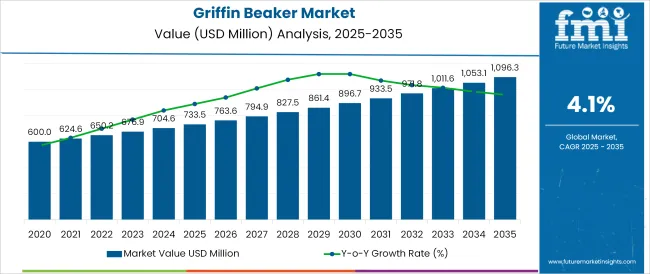
| Attribute | Value |
|---|---|
| Market Size in 2025 | USD 733.5 million |
| Market Size in 2035 | USD 1096.3 million |
| CAGR (2025 to 2035) | 4.1% |
The Griffin beaker market is experiencing consistent growth as laboratory operations across scientific, academic, and industrial settings emphasize precision, durability, and cost effectiveness in glassware and plasticware. Demand is being influenced by the expansion of research activities, increased enrollment in STEM education, and the rising establishment of laboratories in emerging regions.
Evolving preferences for materials that offer both chemical resistance and user safety are shaping product development and procurement decisions. The market outlook is further supported by trends toward sustainability, with growing interest in reusable and recyclable materials, and by the modernization of laboratories seeking to standardize equipment quality.
Enhanced manufacturing technologies, improving consistency and availability of specialized beakers, are paving the path for broader adoption and long-term market expansion.
The market is segmented by Material, Construction, and End User and region. By Material, the market is divided into Plastic and Glass. In terms of Construction, the market is classified into Low form and Tall form. Based on End User, the market is segmented into Research and Academic Institutes, Diagnostic centers and Hospitals, Contract research organization, Pharmaceutical and Biotechnology Companies, and Food & Beverage industries.
Regionally, the market is classified into North America, Latin America, Western Europe, Eastern Europe, Balkan & Baltic Countries, Russia & Belarus, Central Asia, East Asia, South Asia & Pacific, and the Middle East & Africa.
When segmented by material, plastic is projected to hold 58.0% of the total market revenue in 2025, maintaining its position as the leading material choice. This dominance has been driven by the material’s inherent advantages in terms of affordability, impact resistance, and ease of handling compared to traditional glass.
Laboratories have increasingly preferred plastic beakers to reduce breakage-related costs and improve workplace safety, especially in high-throughput or educational environments. Plastic’s versatility in tolerating a range of chemicals and its lightweight nature have contributed to its widespread acceptance.
Advances in polymer technology have further improved temperature and chemical resistance, reinforcing its prominence in routine laboratory applications where reliability and economy are prioritized.
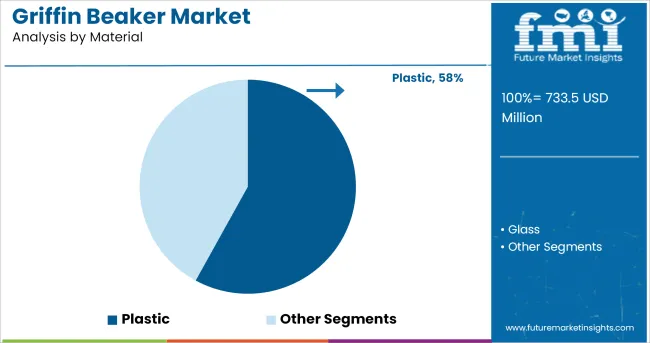
Segmented by construction, the low form variant is expected to account for 62.0% of market revenue in 2025, securing its leadership position. This preference has been shaped by the low form’s practical design, offering enhanced stability, ease of stirring, and reduced risk of tipping during experiments.
Its compact structure and broad base have made it a preferred choice for both novice and experienced users seeking precision and safety. Laboratories have adopted low form beakers widely for routine mixing, heating, and sample preparation tasks, valuing their adaptability across a variety of protocols.
The consistent manufacturing standards and ergonomic advantages associated with low form construction have ensured their continued dominance as the most reliable and convenient design in laboratory settings.
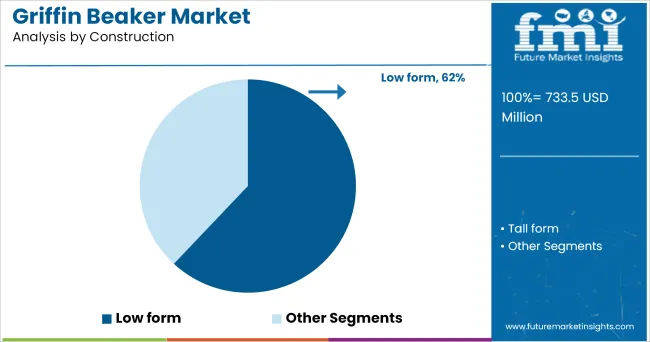
When segmented by end user, research and academic institutes are anticipated to capture 45.0% of the market revenue in 2025, affirming their role as the foremost consumer group. This leading share has been supported by the high volume of laboratory activities in educational and research institutions where beakers are essential tools in teaching and experimentation.
Growing investment in research infrastructure, increased focus on science education, and expanding scientific collaborations have amplified demand from this segment.
The requirement for large quantities of reliable, cost-efficient, and easily replaceable laboratory ware has further reinforced their adoption of Griffin beakers. The steady stream of students, trainees, and researchers in these settings has maintained consistent demand, establishing research and academic institutes as the backbone of the market’s end-user base.
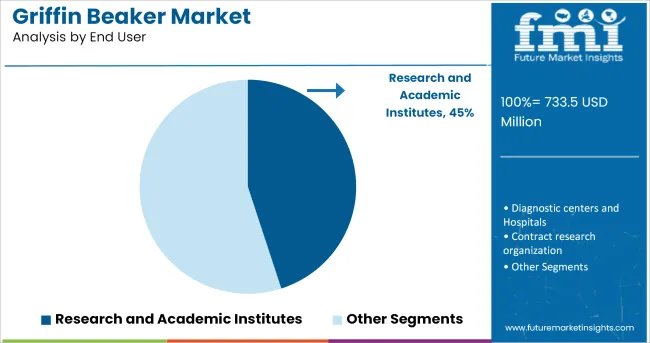
There are various factors that are help in driving the Griffin beaker market. To begin with, rising research in pharmaceutical and biotechnology industries boosts the interest for the Griffin beakers. Because of the easy diagnosis of the diseases, and effective result there is rising preference for the test prior to the treatment moreover contributes to the market development.
In addition, rise in biotechnology and biology research, including disease research, vaccine development and stem cell research is expected to drive the market across the globe. Furthermore, increasing prevalence of chronic diseases have resulted into the development of new drugs which is driving the global market.
Also, technological advancement has resulted into more benefits of using plastic beaker over glass beaker that is additionally helping in growing adoption rate among end users.
Rising number of research in pharmaceutical and biotechnology industries and increase in biotechnology and biology research including stem cells research, disease research, and vaccine development drive the griffin beaker market. Rise in development of new drugs together with routine quality assurance test is expected to increase the adoption of griffin beaker in the future.
Quality assurance tests need extremely accurate volumetric measurements which is provided by griffin beaker. Thus, above-mentioned factors is expected boost the market growth in the coming years.
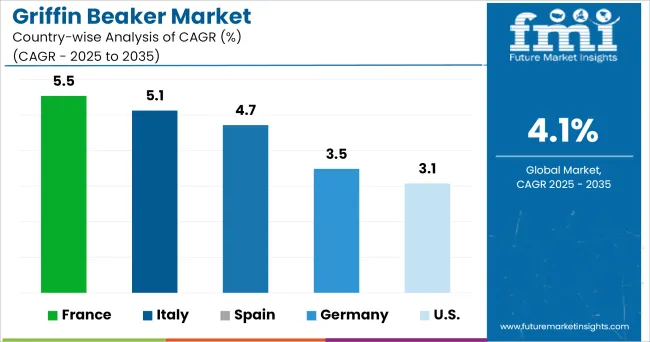
North America, majorly United States and Canada dominated the griffin beaker market. USA griffin beaker market will forecast significant growth due to presence of increased research and development activities in the country. USA is the inventor in research and innovation, investing more amount of money in development of new drugs.
With rise in research and development activities, the interest for high quality precise beaker will rise, in turn, driving the market growth.
In addition, adoption of standard techniques in academic institutions demands the usage of griffin beaker for regular research activities. Aforesaid factors are expected to further create lucrative growth opportunities in the coming years.
Europe is second-biggest market and is relied upon to develop during the forecast years owing to rising demand for diagnostic testing, drug development, and bioprocessing and research.
The growth is also attributable to rising number of academic & research institutions in Europe. Furthermore, rising interest of students towards research is also expected to boost the demand for griffin beaker. In addition, availability of high number of in-house hospital diagnostics and research laboratories together with huge number of domestic players will help the market development over the forecast years.
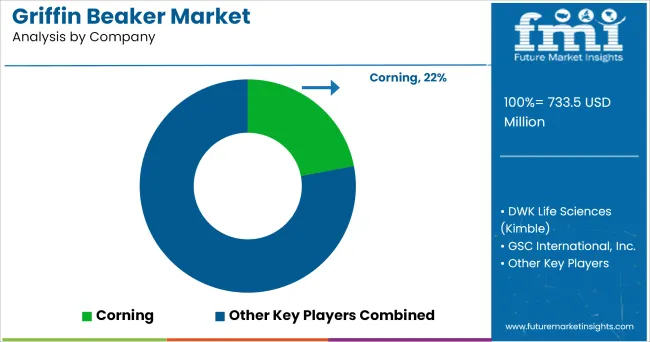
Some of the leading manufacturers and suppliers of griffin beaker include
The griffin beaker market is highly fragmented, with the existence of a many of large-scale players available in global markets, and various small-scale participants in regional markets. Major players are associated in adopting strategies like acquisitions and mergers, launching new products, and partnerships to consolidate their position in the market.
Also, major players are funding largely in the in the research and development to produce advanced products.
The report is a compilation of first-hand information, qualitative and quantitative assessment by industry analysts, inputs from industry experts and industry participants across the value chain. The report provides in-depth analysis of parent market trends, macro-economic indicators and governing factors along with market attractiveness as per segments.
The report also maps the qualitative impact of various market factors on market segments and geographies.
The global griffin beaker market is estimated to be valued at USD 733.5 million in 2025.
The market size for the griffin beaker market is projected to reach USD 1,096.3 million by 2035.
The griffin beaker market is expected to grow at a 4.1% CAGR between 2025 and 2035.
The key product types in griffin beaker market are plastic and glass.
In terms of construction, low form segment to command 62.0% share in the griffin beaker market in 2025.






Our Research Products

The "Full Research Suite" delivers actionable market intel, deep dives on markets or technologies, so clients act faster, cut risk, and unlock growth.

The Leaderboard benchmarks and ranks top vendors, classifying them as Established Leaders, Leading Challengers, or Disruptors & Challengers.

Locates where complements amplify value and substitutes erode it, forecasting net impact by horizon

We deliver granular, decision-grade intel: market sizing, 5-year forecasts, pricing, adoption, usage, revenue, and operational KPIs—plus competitor tracking, regulation, and value chains—across 60 countries broadly.

Spot the shifts before they hit your P&L. We track inflection points, adoption curves, pricing moves, and ecosystem plays to show where demand is heading, why it is changing, and what to do next across high-growth markets and disruptive tech

Real-time reads of user behavior. We track shifting priorities, perceptions of today’s and next-gen services, and provider experience, then pace how fast tech moves from trial to adoption, blending buyer, consumer, and channel inputs with social signals (#WhySwitch, #UX).

Partner with our analyst team to build a custom report designed around your business priorities. From analysing market trends to assessing competitors or crafting bespoke datasets, we tailor insights to your needs.
Supplier Intelligence
Discovery & Profiling
Capacity & Footprint
Performance & Risk
Compliance & Governance
Commercial Readiness
Who Supplies Whom
Scorecards & Shortlists
Playbooks & Docs
Category Intelligence
Definition & Scope
Demand & Use Cases
Cost Drivers
Market Structure
Supply Chain Map
Trade & Policy
Operating Norms
Deliverables
Buyer Intelligence
Account Basics
Spend & Scope
Procurement Model
Vendor Requirements
Terms & Policies
Entry Strategy
Pain Points & Triggers
Outputs
Pricing Analysis
Benchmarks
Trends
Should-Cost
Indexation
Landed Cost
Commercial Terms
Deliverables
Brand Analysis
Positioning & Value Prop
Share & Presence
Customer Evidence
Go-to-Market
Digital & Reputation
Compliance & Trust
KPIs & Gaps
Outputs
Full Research Suite comprises of:
Market outlook & trends analysis
Interviews & case studies
Strategic recommendations
Vendor profiles & capabilities analysis
5-year forecasts
8 regions and 60+ country-level data splits
Market segment data splits
12 months of continuous data updates
DELIVERED AS:
PDF EXCEL ONLINE
Industry Share Analysis for Griffin Beaker Manufacturers
Stackable Beaker Market Size and Share Forecast Outlook 2025 to 2035

Thank you!
You will receive an email from our Business Development Manager. Please be sure to check your SPAM/JUNK folder too.
Chat With
MaRIA